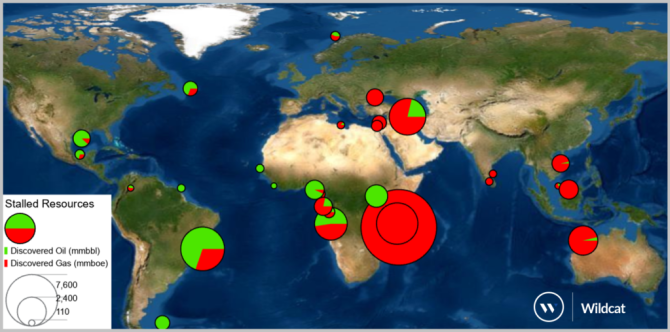
(Source: Andrey Priyatkin/Shutterstock.com)
About 36 Bboe gas and 11 Bbbl of oil remain locked across the world, held captive by fiscal terms, access to finance, portfolio prioritization and subsurface issues, a new study shows.
The stalled resources comprise nearly 120 discoveries made between 2008 and 2016, according to Westwood Global Energy Group, the U.K.-headquartered oil and gas market research consultancy that conducted the study.
“Westwood estimates that the industry has spent about $25 billion exploring for these assets and the same amount in appraisal following discovery [for] a total of about $50 billion,” Graeme Bagley, head of global exploration and appraisal for Westwood, told Hart Energy.
Based on recent transaction values of assets globally and assuming $1.20/boe for gas and $2/bbl for oil, Westwood estimates the value of the stalled assets at around $65 billion.
Westwood called it “surprising and concerning that 40% of the resource found in discoveries >100 million boe size made between 2008 and 2016 remains stalled, with no appraisal activity or indications of progression to FID since 2016. These stalled assets are an opportunity for companies with the means to unlock them.”
The study was released in late October as oil and gas companies across the world continued to operate within tight budgets amid oil price volatility. New lockdowns spawned by rising coronavirus cases, supply debates by OPEC+ and calls for sustainable energy development, efficiency gains and a low cost of supply resource base are among the factors at play.
Meeting Oil, Gas Demand
The stalled resources could add value for companies with the financial ability and skill set required to pursue development of these assets, especially given global demand for oil and gas in emerging markets.

Plus, as the International Energy Agency (IEA) pointed out in its World Energy Outlook “declines in production from existing fields create a need for new upstream projects, even in rapid energy transitions.”
Bagley added “demand for hydrocarbons will not disappear overnight,” referencing the IEA sustainable development scenario that forecasts oil demand at about 74 MMbbl/d in 2040, down 26% compared to today.
Global gas demand is expected to rise but not to levels initially forecast by the IEA. After adjusting for COVID-19, the IEA said global natural gas demand is expected to surpass 4,370 Bcm annually in 2025. That represents a growth rate of about 1.5% per year between 2019 and 2025, down from the 1.8% per year previously forecast.
“Much of the stranded resource is gas, which is seen as a key clean source of energy in the transition,” Bagley said. “Many of the stalled oil discoveries should be able to be monetized over a fairly short cycle time if the barriers to development can be overcome. Others may be more challenging.”
Subsurface, Aboveground Factors
At about 128 Tcf, most of the stalled gas is in the Ruvuma-Rufiji basins of Mozambique and Tanzania. Though Westwood said aboveground factors such as fiscal regimes and gas terms are mainly why these discoveries are at a standstill, a combination of aboveground and subsurface issues impacted progress on 14 deepwater gas developments that comprise five possible developments in Tanzania.
“The aboveground issues are mainly related to protracted negotiations with the Tanzanian government on gas terms,” Westwood said. “Reservoirs are more compartmentalized than in neighboring Mozambique with lower resource densities and higher development costs.”
Subsurface issues are also behind stalled resources at six discoveries in Brazil’s Santos Basin, where the Jupiter discovery awaits technology to handle large volumes of CO2 at the field. Petrobras, the field’s operator, is working to validate its HISEP high-pressure separation technology, which involves separating and reinjecting of produced CO2 into reservoir rocks using equipment installed on the seabed. The technology is being tested at the deepwater Mero Field in the Santos Basin’s Libra Block.
Brazil has the most stalled oil and condensate resource at 3.8 Bbbl in five basins, according to Westwood. Low reservoir quality and smaller plays pushed other presalt discoveries—including Dolomita Sul, Bigua and Bem-Te-Vi pre-salt discoveries—down and eventually off of Petrobras’ priority list.
Iraqi Kurdistan’s share of the stalled gas resources is about 16.5 Tcf, and Australia’s Browse and Carnarvon basins has about 14 Tcf.
Westwood estimates Angola’s Kwanza—also plagued by subsurface and aboveground challenges—and Lower Congo basins has about 3 Bboe of oil and gas, while more than 500 MMboe are stalled in each of Canada, Cyprus, the Falkland Islands, Gabon, Malaysia, Nigeria, Romania, Uganda, the U.S. and Vietnam.
Moving Forward
Westwood identified three avenues that can be taken to move these discoveries forward. Among these were better gas terms and gas market access along with application of new technologies such as ultra-HP/HT completions to unlock Paleogene plays in northern Gulf of Mexico. Westwood believes technology could aid in the development of 2.5 Bboe of resources from 10 discoveries.
Appraisal drilling could also shed light on potential upside, giving companies the incentive to pursue development. Westwood reported that 46 of the stalled discoveries have not been appraised.
However, “many of the discoveries have already been appraised and the subsurface uncertainty has been addressed,” Bagley said. “The focus for these will be negotiation of better terms to improve project economics. Others may require new geological models to quantify the level of upside that may be accessed via appraisal.”
Though budgets for exploration and appraisal activity may not be as large as they were in past years for most companies, some are still chasing new resources.
“Some of the largest volumes of stalled gas resources are found in Africa and Australia,” Bagley said. “Total’s recent discoveries offshore South Africa and BP’s recently spudded well in the Australian North West Shelf indicate that the appetite for exploration still exists, even though any discoveries made also risk being stalled.”

